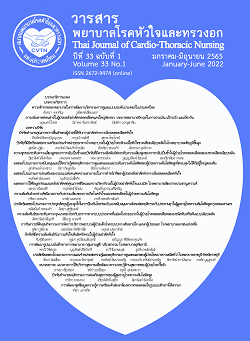ความสัมพันธ์ระหว่างการรับรู้ในการปฏิบัติพฤติกรรมสุขภาพ แรงสนับสนุนทางสังคม และพฤติกรรมสุขภาพเพื่อป้องกันโรคหัวใจและหลอดเลือด ในบุคลากรที่เป็นกลุ่มเสี่ยงต่อโรคเบาหวานของมหาวิทยาลัยเอกชนแห่งหนึ่ง
คำสำคัญ:
พฤติกรรมสุขภาพเพื่อป้องกันโรคหัวใจและหลอดเลือด, กลุ่มเสี่ยงสูงต่อโรคเบาหวาน, การรับรู้ในการปฏิบัติพฤติกรรมสุขภาพ, แรงสนับสนุนทางสังคมบทคัดย่อ
การศึกษาเชิงพรรณนาครั้งนี้ ศึกษาความสัมพันธ์ระหว่างการรับรู้ในการปฏิบัติพฤติกรรมสุขภาพและแรงสนับสนุนทางสังคมกับพฤติกรรมสุขภาพเพื่อป้องกันโรคหัวใจและหลอดเลือดในบุคลากรที่เป็นกลุ่มเสี่ยงต่อโรคเบาหวานของมหาวิทยาลัยเอกชนแห่งหนึ่ง จำนวน 101 คน เก็บข้อมูลด้วย แบบบันทึกข้อมูลส่วนบุคคลและข้อมูลด้านสุขภาพ แบบสอบถามการรับรู้ประโยชน์ การรับรู้อุปสรรค การรับรู้ความสามารถของตนเอง และแรงสนับสนุนทางสังคม ในการปฏิบัติพฤติกรรมสุขภาพเพื่อป้องกันการเกิดโรคหัวใจและหลอดเลือด และแบบสอบถามพฤติกรรมสุขภาพเพื่อป้องกันการเกิดโรคหัวใจและหลอดเลือด วิเคราะห์ข้อมูลด้วยสถิติพรรณนาและสถิติวิเคราะห์ค่าสัมประสิทธิ์สหสัมพันธ์เพียร์สันหรือสัมประสิทธิ์สหสัมพันธ์สเปียร์แมน
ผลการวิจัยพบว่า กลุ่มตัวอย่างมีค่าเฉลี่ยการรับรู้ประโยชน์ในระดับสูง ค่าเฉลี่ยการรับรู้อุปสรรค การรับรู้ความสามารถของตนเอง แรงสนับสนุนทางสังคม และพฤติกรรมสุขภาพเพื่อป้องกันการเกิดโรคหัวใจและหลอดเลือดอยู่ในระดับปานกลาง พฤติกรรมสุขภาพเพื่อป้องกันการเกิดโรคหัวใจและหลอดเลือดโดยรวมอยู่ในระดับปานกลาง การรับรู้ประโยชน์ การรับรู้ความสามารถของตนเอง และแรงสนับสนุนทางสังคมในการปฏิบัติพฤติกรรมสุขภาพเพื่อป้องกันโรคหัวใจและหลอดเลือด มีความสัมพันธ์ทางบวกกับพฤติกรรมสุขภาพเพื่อป้องกันโรคหัวใจและหลอดเลือดอย่างมีนัยสำคัญทางสถิติ (r=0.286, p<0.01; r=0.588, p<0.001; r=0.337, p<0.001 ตามลำดับ) ส่วนการรับรู้อุปสรรคมีความสัมพันธ์ทางลบกับพฤติกรรมสุขภาพเพื่อป้องกันโรคหัวใจและหลอดเลือดอย่างมีนัยสำคัญทางสถิติ (r=-0.548, p<0.001)
ผลการศึกษาเสนอให้หน่วยงานมีกิจกรรมส่งเสริมพฤติกรรมสุขภาพสำหรับบุคลากรที่มีความเสี่ยงต่อโรคเบาหวาน โดยเฉพาะด้านการรับประทานอาหารและการออกกำลังกาย และควรมีการวิจัยติดตามประเมินผลต่อเนื่องระยะยาว
เอกสารอ้างอิง
World Heart Federation. World heart day. [cited 2019 Sep 15] Available from: https://www.world-heart-federation.org/world-heart-day/world-heart-day-2019
Division of Non-Communicable Disease. Annual report 2018. [cited 2019 Nov 25] Available from: http://www.thaincd.com/ document/file/download/paper-manual/Annual NCD61.pdf (in Thai).
Paneni F, Cosentino F. Diabetes and cardiovascular disease. Switzerland: Springer International; 2015.
Diabetes Association of Thailand. Clinical practice guideline for diabetes 2017. Bangkok: Rom yen media; 2017.
Diabetes Association of Thailand. prevalence of diabetes in thai population 2009, 2014. [cited 2019 Oct 30] Available from: https://www.dmthai.org/ index.php/knowledge/ the-chart/the-chart-1 (in Thai).
Division of Non-Communicable Disease. Assessment of risk for cardiovascular disease of Diabetes and Hypertension patients. Bangkok: The Agricultural Cooperative Federation of Thailand. Limited; 2015. (in Thai).
American Diabetes Association. Standards of medical care in diabetes-2020. Diabetes Care, 2020. [cited 2019 Dec 10] Available from: https://care. diabetesjournals.org/ content/diacare/suppl/2019/12/20/43.Supplement_1.DC1/DC_43_S1_2020.pdf
Division of Non-Communicable Disease. Behavioral risk factors surveillance system: BRFSS of 2016 [cited 2019 Nov 20] Available from: http://www.thaincd.com/ document/file/ info/brfss/ (in Thai).
Pender NJ, Murdaugh CL, Parsons MA. Health promotion in nursing practice. 6th ed. New Jersey: Pearson Education; 2011.
Pichayapinyo P, Lagampan S, Sujirarat D, Kaewpan W. Factors Associated with Health Behavior in Diabetic Patients with Risk of Cardiovascular Disease. Health Systems Research Institute (HSRI). 2015. (in Thai).
Deepae P, Khungtumneam K, Chumpathat N. Factors Related to Health Promoting Behaviors for Cardiovascular Disease Preventionamong Diabetes with Hypertension Patients in Muang District, Chachoengsao Province. Journal of Health and Nursing Research. 2019; 35(3): 46-59. (in Thai).
Na Thalang R, Detjob N, Yuntapun A, Setthawong K, Kunaratnpruk S. Effects of a self – efficacy promotion program on metabolic syndrome prevention behaviors among Rangsit University personnel. Journal of Nursing and Health Care. 2018; 36(1): 172-80. (in Thai).
Mahidol University. Thai CV Risk Score; Thai CV 2015. [cited 2019 Nov 15] Available from: https://med.mahidol.ac.th/cardio_vascular_risk/thai_cv_risk_score/#regat3 (in Thai).
Best JW, Kahn JV. Research in education. 7rd ed. Englewood Cliffs, New Jersey: Prentice-Hall; 1993.
Korakotkamjon P, Namjuntra R, Tangkawanich T. Knowledge, cardiovascular risk and health behaviors among patients with diabetes and hypertension in Mueang Chiangrai district. Thai Journal of Cardio-Thoracic Nursing. 2020; 31(1): 46-61. (in Thai).
Sittikankaew K, Navicharoen R. Factors Related to Health Promoting Behaviors of Type 2 Diabetes Patients with Insulin and Oral Agent Therapy. Journal of The Police Nurse. 2014; 6(1): 102-112. (in Thai).
Panthu K, Maneewong J. Factors Predicting Health Promoting Behaviors of the Elderlies with Type 2 Diabetes in the Central Region of Thailand. The Journal of Baromarajonani College of Nusing, Nakhonratchasima. 2016; 22(1): 93-107. (in Thai).
ดาวน์โหลด
เผยแพร่แล้ว
รูปแบบการอ้างอิง
ฉบับ
ประเภทบทความ
สัญญาอนุญาต
ลิขสิทธิ์ (c) 2022 วารสารพยาบาลโรคหัวใจและทรวงอก

อนุญาตภายใต้เงื่อนไข Creative Commons Attribution-NonCommercial-NoDerivatives 4.0 International License.
บทความนี้ยังไม่เคยตีพิมพ์หรืออยู่ในระหว่างส่งไปตีพิมพ์ในวารสารอื่น ๆ มาก่อน และกองบรรณาธิการขอสงวนสิทธิ์ในการตรวจทาน และแก้ไขต้นฉบับตามเกณฑ์ของวารสาร ในกรณีที่เรื่องของท่านได้ได้รับการตีพิมพ์ในวารสารฉบับนี้ถือว่าเป็น ลิขสิทธิ์ของวารสารพยาบาลโรคหัวใจและทรวงอก






